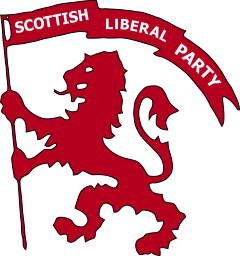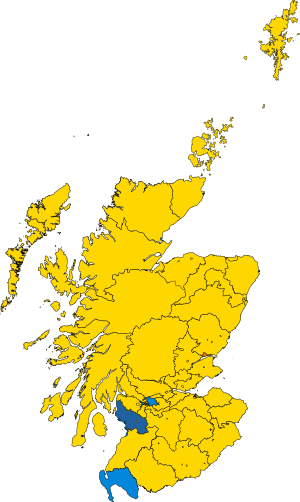Scottish Liberal Party facts for kids
Quick facts for kids
Scottish Liberal Party
|
|
|---|---|
 |
|
| Founded | 1859 |
| Dissolved | 3 March 1988 |
| Merged into | Scottish Liberal Democrats |
| Headquarters | 2 Atholl Place, Edinburgh |
| Ideology | Liberalism Classical liberalism Social liberalism |
| National affiliation | Liberal Party |
The Scottish Liberal Party, the section of the Liberal Party in Scotland, was the dominant political party of Victorian Scotland, and although its importance declined with the rise of the Labour and Unionist parties during the 20th century, it was still a significant, albeit much reduced force when it finally merged with the Social Democratic Party in Scotland, to form the Scottish Liberal Democrats in 1988.
The party lost its last remaining seats in the UK Parliament in 1945, and continued to decline in popular support in the post war years, with Jo Grimond (who won back Orkney and Shetland in 1950) being the sole Scottish Liberal MP in the House of Commons from 1951 to 1964. The party gained a partial revival in the 1964 general election returning three further MPs; George Mackie, Russell Johnston and Alasdair Mackenzie. A further gain came the following year with David Steel's victory at the Roxburgh, Selkirk and Peebles by-election. Steel went on to become a pivotal figure in the development of Scottish devolution, in partnership with John Smith, Donald Dewar and other key Labour and Liberal figures.
Victorian party
The Victorian Liberal party in Scotland was not always ideologically unified, and was faced with many internal divisions, particularly amongst the more conservative Whiggish elements of the party who were largely based in Edinburgh and the East, and the more western and Glasgow-based radical Liberals.
The East and North of Scotland Liberal Association and the West and South West of Scotland Liberal Association were founded in 1877. Early in 1881, they merged, forming the Scottish Liberal Association, led by Gladstone and Adam. A National Liberal Federation of Scotland was founded in April 1886, but merged into the Liberal Association in December.
The Scottish Women's Liberal Federation was formed in 1891 from regional groups and was led by Anne Lindsay.
Leadership
Chairmen
- 1886: Victor Bruce
- 1894: Thomas Gibson-Carmichael
- 1902: Edward Marjoribanks
- 1906: John William Crombie
- 1908: Eugene Wason
- 1909: George Green
- 1910: Eugene Wason
- 1912: William Robertson
- 1921: Donald Maclean
- 1925: John Anthony
- 1933: William Baird
- 1936: Archibald Sinclair
- 1936: Philip Kerr
- 1946: Louise Glen-Coats
- 1948: Leonard T. M. Gray
- 1952: Louise Glen-Coats
- 1953: John Gray Wilson
- 1954: Charles Hampton Johnston
- 1956: John Bannerman
- 1965: George Mackie
- 1970: Russell Johnston
- 1973: Robert L. Smith
- 1975: Menzies Campbell
- 1977: Terry Grieve
- 1980: Fred McDermid
- 1982: Ross Finnie
- 1986: John Lawrie
- 1987: Christopher Mason
Presidents
- 1880s: John Dalrymple
- 1884: Alexander Duff
- 1886: Archibald Primrose
- 1901: Henry Campbell-Bannerman
- 1909: H. H. Asquith
- 1928: John Hamilton-Gordon
- 1934: Ramsay Muir
- 1935: Archibald Sinclair
- 1960: Archibald Sinclair and Andrew Murray
- 1961: Archibald Sinclair
- 1963: Archibald Sinclair and John Bannerman
- 1965: John Bannerman
- 1969: Ray Bannerman (later Ray Michie)
- 1976: Robert L. Smith
- 1982: Fred McDermid
- 1983: George Mackie
Leader
- Until 1973, the party was led by the president.
- Russell Johnston, 1973–1988
Electoral performance
This chart shows the electoral results of the Scottish Liberal Party, from its first election in 1859, to its last in 1983. Total number of seats, and vote percentage, is for Scotland only.
| Election | National leader in Scotland | Vote % | Seats | Government |
|---|---|---|---|---|
| 1859 | — | 66.4 |
40 / 53
|
Liberal |
| 1865 | — | 85.4 |
42 / 53
|
Liberal |
| 1868 | — | 82.5 |
51 / 58
|
Liberal |
| 1874 | — | 68.4 |
40 / 58
|
Conservative |
| 1880 | — | 70.1 |
52 / 58
|
Liberal |
| 1885 | William Ewart Gladstone for Midlothian | 53.3 |
51 / 70
|
Liberal minority |
| 1886 | William Ewart Gladstone for Midlothian | 53.6 |
43 / 70
|
Conservative–Liberal Unionist |
| 1892 | William Ewart Gladstone for Midlothian | 53.9 |
51 / 70
|
Liberal minority |
| 1895 | — | 51.7 |
39 / 70
|
Conservative–Liberal Unionist |
| 1900 | Sir Henry Campbell-Bannerman for Stirling Burghs | 50.2 |
34 / 70
|
Conservative–Liberal Unionist |
| 1906 | Sir Henry Campbell-Bannerman for Stirling Burghs | 56.4 |
58 / 70
|
Liberal |
| Jan 1910 | H. H. Asquith for East Fife | 54.2 |
58 / 70
|
Liberal minority |
| Dec 1910 | H. H. Asquith for East Fife | 53.6 |
57 / 70
|
Liberal minority |
| 1918 | H. H. Asquith for East Fife (defeated) | Official Liberal 15.0 Coalition Liberal 19.1 |
Official Liberal 8 / 71
Coalition Liberal 25 / 71
|
Coalition Liberal–Conservative |
| 1922 | H. H. Asquith for Paisley | Official Liberal 21.5 National Liberal 17.7 |
Official Liberal 15 / 71
National Liberal 12 / 71
|
Conservative |
| 1923 | H. H. Asquith for Paisley | 28.4 |
22 / 71
|
Labour minority |
| 1924 | H. H. Asquith for Paisley | 16.6 |
8 / 71
|
Conservative |
| 1929 | — | 18.1 |
13 / 71
|
Labour minority |
| 1931 | — | 8.6 |
7 / 71
|
National Labour–Conservative–Liberal |
| 1935 | — | 6.7 |
3 / 71
|
Conservative–National Labour–Liberal National |
| 1945 | Sir Archibald Sinclair for Caithness and Sutherland | 5.6 |
0 / 71
|
Labour |
| 1950 | — | 6.6 |
2 / 71
|
Labour |
| 1951 | — | 2.7 |
1 / 71
|
Conservative |
| 1955 | — | 1.9 |
1 / 71
|
Conservative |
| 1959 | Jo Grimond for Orkney and Shetland | 4.1 |
1 / 71
|
Conservative |
| 1964 | Jo Grimond for Orkney and Shetland | 7.6 |
4 / 71
|
Labour |
| 1966 | Jo Grimond for Orkney and Shetland | 6.8 |
5 / 71
|
Labour |
| 1970 | — | 5.5 |
3 / 71
|
Conservative |
| February 1974 | — | 7.9 |
3 / 71
|
Labour minority |
| October 1974 | — | 8.3 |
3 / 71
|
Labour |
| 1979 | David Steel for Roxburgh, Selkirk and Peebles | 9.0 |
3 / 71
|
Conservative |


